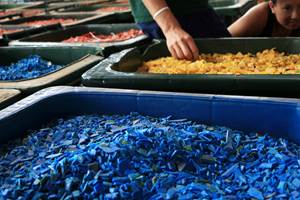Calcium Carbonate From Carbon Capture for Brighter Plastics and Greener Steel
CarbonFree is converting steel slag and blast furnace exhaust into an important plastic compounding additive.
Calcium carbonate (CaCO3) has a variety of important applications including as a concrete aggregate, dietary supplement, extender in paints and plastics compounding additive. It is a naturally occurring mineral, and can be sourced for some applications by extracting limestone or marble and crushing, grinding and screening. But where greater control of size and shape is required, a synthetic, precipitated calcium carbonate (PCC) is created.
The production of PCC traditionally involves heating limestone to high temperatures to form quicklime (CaO), which is then hydrated to form calcium hydroxide (Ca(OH)2). Carbon dioxide (CO2) gas is added, causing calcium carbonate to precipitate out. The consistency and control come at a cost: the production of PCC requires high energy use and has a substantially higher carbon footprint — as much as 3 times that of mining naturally occurring calcium carbonate.
The company is introducing an alternative that can not only cut carbon emissions from extraction but also divert waste material from another high emissions operation: steel production.

In CarbonFree’s production process, steel slag is converted to endurocal calcium carbonate (PCC). Source: CarbonFree.
Globally, most steel production is done by the basic oxygen process, so called because bases are added to molten iron to remove impurities. Byproducts include carbon dioxide released from the blast furnace and steel slag produced when the impurities are separated from molten metal. CarbonFree’s process captures both.
“The CO2 from the blast furnace is a big win, because they get a carbon reduction and can claim an amount of green steel associated with that, but slag can be just as big of an issue. The steel industry has millions of tons of this slag, some of it is recycled as asphalt but a lot of it is stored on-site, so finding a use for it is a second huge win,” says CarbonFree CEO Martin Keighley.
The process, called SkyCycle (Fig. 1), revolves around the decomposition of magnesium chloride (MgCl2) into magnesium hydroxide (Mg(OH)2) and hydrogen chloride (HCl). HCl is used to dissolve steel slag (dissolution) to form calcium chloride (CaCl2). MgOH2 is reacted with CO2 from blast furnace gas (decarbonation) to make magnesium bicarbonate (MgOH(HCO3)), which in turn reacts with calcium chloride to form calcium carbonate (the endurocal product) and magnesium chloride, which is heated in the decomposition process, completing the cycle. Remaining HCl from the reaction can be fed back into dissolution or sold as a byproduct.

Fig. 1: CarbonFree’s SkyCycle Process, in which steel slag and blast furnace exhaust becomes calcium carbonate. Source: CarbonFree.
Because the carbon dioxide extracted from the blast furnace gas is greater than the emissions from the energy applied to the system, the process has a net of zero carbon emissions overall, passing a reduction to the customer.
“The quality of our material is pharmacuetical/food grade and we intend to target that market as well as paints, coatings and plastics,” says Bill Bryant, director of marketing at CarbonFree. “Our product compares well to the PCCs that are used in making PVC.” Calcium carbonate is used in PVC as an acid scavenger, to provide color, to improve tensile strength and as an impact modifier. In polyolefins, calcium carbonate is used as an antiblock and whitening agent.
CarbonFree discovered early on that its process made a particularly bright white calcium carbonate. This property of endurocal could enable adjustments to compounding formulas, reducing the need for expensive titanium dioxide (TiO2) for whitening. “If we can bring more brightness and lightness to the application, our customers can reduce their formulation costs,” Bryant says.
In 2024, CarbonFree entered an agreement with to build a plant on-site at the Gary Steel Works in Gary, Indiana. Backlogs in equipment availability have delayed construction, now expected to be completed in 2027. The proximity of the Gary Steel Works to rail and shipping infrastructure is expected to facilitate distribution of endurocal to regional and global customers. When operational, it is expected to capture and mineralize up to 50,000 metric tons of CO2 per year.
In the meantime, CarbonFree is making endurocal in testing quantities at the Southwest Research Institute in San Antonio, Texas, and providing samples to customers working in a variety of applications. “It’s often the case that when you go down a sustainability road you end up with a compromise. This is a little bit different, this is sustainability and performance, which we’re very excited about,” Keighley says.

The SkyCycle process unit alongside existing structures at Gary Steel Works on Lake Michigan.
Source: CarbonFree
Related Content
Looking to Run More Regrind? PTXPO Workshop Tackles How
When it comes to making injection molding operations more sustainable, the lowest hanging fruit is the use of regrind, but that doesn’t mean it’s not without challenges.
Read MoreAt NPE2024, Follow These Megatrends in Materials and Additives
Offerings range from recycled, biobased, biodegradable and monomaterial structures that enhance recyclability to additives that are more efficient, sustainable and safer to use.
Read MoreBASF Highlighting How They 'Make, Use and Recycle Future Solutions'
NPE2024: BASF is using its proprietary computer-aided engineering tool Ultrasim when designing for sustainability in a broad range of industries.
Read MoreNPE2024 Materials: Spotlight on Sustainability with Performance
Across the show, sustainability ruled in new materials technology, from polyolefins and engineering resins to biobased materials.
Read MoreRead Next
Lead the Conversation, Change the Conversation
Coverage of single-use plastics can be both misleading and demoralizing. Here are 10 tips for changing the perception of the plastics industry at your company and in your community.
Read MoreMaking the Circular Economy a Reality
Driven by brand owner demands and new worldwide legislation, the entire supply chain is working toward the shift to circularity, with some evidence the circular economy has already begun.
Read More











